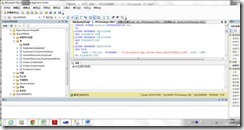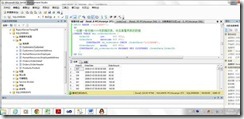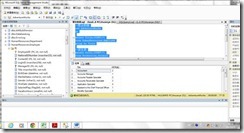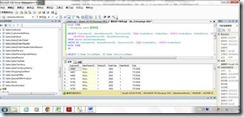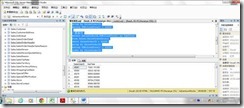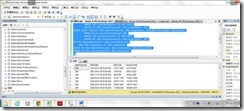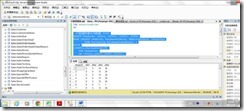《SQL Server 2008 从入门到精通》 学习笔记 第三天
2012-02-02 15:43 CodeCy 阅读(554) 评论(0) 编辑 收藏 举报分区
分区函数
use SQL2008SBS go create partition function mypartfunction (int) as range left for values (10,20,30,40,50,60)
对新表进行分区
 View Code
View Code
USE SQL2008SBS GO CREATE SCHEMA Archive AUTHORIZATION dbo GO ALTER DATABASE SQL2008SBS ADD FILEGROUP FG2 ALTER DATABASE SQL2008SBS ADD FILEGROUP FG3 GO ALTER DATABASE SQL2008SBS ADD FILE (NAME = FG2_dat, FILENAME = 'D:\Documents\SQL Server\Data\SQL2008SBS_4.ndf', SIZE = 2MB) TO FILEGROUP FG2 ALTER DATABASE SQL2008SBS ADD FILE (NAME = FG3_dat, FILENAME = 'D:\Documents\SQL Server\Data\SQL2008SBS_5.ndf', SIZE = 2MB) TO FILEGROUP FG3 GO CREATE PARTITION FUNCTION shipdatepartfunc (date) AS RANGE RIGHT FOR VALUES ('1/1/2007','1/1/2008') GO CREATE PARTITION SCHEME shipdatepartscheme AS PARTITION shipdatepartfunc TO (FG1, FG2, FG3) GO --We want the primary key to be nonclustered so that -- we can create a clustered index to partition the table CREATE TABLE Archive.OrderDetail( OrderDetailID INT IDENTITY(1,1) NOT NULL, OrderID INT NOT NULL, SKU CHAR(10) NOT NULL, Quantity INT NOT NULL, UnitPrice MONEY NOT NULL, ShipDate DATE NOT NULL) ON shipdatepartscheme(ShipDate) GO CREATE CLUSTERED INDEX icx_shipdate ON Archive.OrderDetail(ShipDate) ON shipdatepartscheme(ShipDate) GO ALTER TABLE Archive.OrderDetail ADD CONSTRAINT pk_orderdetail PRIMARY KEY NONCLUSTERED (OrderDetailID, ShipDate) ON shipdatepartscheme(ShipDate) GO CREATE TABLE Archive.OrderHeader( OrderID INT IDENTITY(1,1) NOT NULL, CustomerID INT NOT NULL, OrderDate DATE NOT NULL, SubTotal MONEY NOT NULL, TaxAmount MONEY NOT NULL, ShippingAmount MONEY NOT NULL, GrandTotal AS ((SubTotal+TaxAmount)+ShippingAmount), FinalShipDate DATE NOT NULL) ON shipdatepartscheme(FinalShipDate) GO ALTER TABLE Archive.OrderHeader ADD CONSTRAINT pk_orderheader PRIMARY KEY NONCLUSTERED(OrderID, FinalShipDate) ON shipdatepartscheme(FinalShipDate) GO CREATE CLUSTERED INDEX icx_finalshipdate ON Archive.OrderHeader(FinalShipDate) ON shipdatepartscheme(FinalShipDate) GO
管理分区
 View Code
View Code
USE SQL2008SBS GO CREATE PARTITION FUNCTION partfunc (datetime) AS RANGE RIGHT FOR VALUES ('1/1/2005','1/1/2006') GO CREATE PARTITION SCHEME partscheme AS PARTITION partfunc TO (FG1, FG2, FG3) GO CREATE TABLE dbo.orders ( OrderID int identity(1,1), OrderDate datetime NOT NULL, OrderAmount money NOT NULL CONSTRAINT pk_orders PRIMARY KEY CLUSTERED (OrderDate,OrderID)) ON partscheme(OrderDate) GO SET NOCOUNT ON DECLARE @month int = 1, @day int = 1, @year int = 2005 WHILE @year < 2007 BEGIN WHILE @month <= 12 BEGIN WHILE @day <= 28 BEGIN INSERT dbo.orders (OrderDate, OrderAmount) SELECT CAST(@month AS VARCHAR(2)) + '/' + CAST(@day AS VARCHAR(2)) + '/' + CAST(@year AS VARCHAR(4)), @day * 20 SET @day = @day + 1 END SET @day = 1 SET @month = @month + 1 END SET @day = 1 SET @month = 1 SET @year = @year + 1 END GO --查看单个分区中的数据 SELECT * FROM dbo.orders WHERE $partition.partfunc(OrderDate)=3 GO --更改分区函数,引入新的范围并且设置下一个被使用的文件组 ALTER PARTITION SCHEME partscheme NEXT USED FG1; GO ALTER PARTITION FUNCTION partfunc() SPLIT RANGE ('1/1/2007'); GO --创建一张切换年数据的表,并且查看两表的数据 CREATE TABLE dbo.ordersarchive ( OrderID int NOT NULL, OrderDate datetime NOT NULL CONSTRAINT ck_orderdate CHECK (OrderDate<'1/1/2006'), OrderAmount money NOT NULL CONSTRAINT pk_ordersarchive PRIMARY KEY CLUSTERED (OrderDate,OrderID) ) ON FG2 GO SELECT * FROM dbo.orders SELECT * FROM dbo.ordersarchive GO --将年的数据切换到归档表,并查看结果 ALTER TABLE dbo.orders SWITCH PARTITION 2 TO dbo.ordersarchive GO SELECT * FROM dbo.orders SELECT * FROM dbo.ordersarchive GO --删除为指定的边界点 ALTER PARTITION FUNCTION partfunc() MERGE RANGE ('1/1/2005'); GO --删除相关测试对象,对数据库进行清理 DROP TABLE dbo.orders DROP TABLE dbo.ordersarchive DROP PARTITION SCHEME partscheme DROP PARTITION FUNCTION partfunc GO
数据检索与操作
数据的检索
通用select语句
select 1 select 'select 1' select ' this is a character constant', ' this is another character constant', 1, '7/27/2008' select * from Person.Address select AddressID,AddressLine1,AddressLine2,City,StateProvinceID,PostalCode from Address
--COUNT函数
select COUNT(*) from Address
--CASE 函数
select ShipMethodID,case ShipMethodID when 1 then 'A.Datum' when 2 then 'Contoso' when 3 then 'Consolidated Messenger' else 'Unknow' end from Purchasing.PurchaseOrderHeader r
结果排序
--order by
select addressID, AddressLine1 + '' + ISNULL(AddressLine2,''),City,StateProvinceID from Address order by addressID
多个表中索引数据
USE AdventureWorks
GO
--数据筛选
select productID, Name , ProductNumber, ListPrice, DaysToManufacture from Production.Product where productSubCategoryID in (1,2,2) select productID, Name , ProductNumber, ListPrice, DaysToManufacture from Production.Product where name like 's_M%'
--NULL
select productID, Name , ProductNumber, ListPrice, DaysToManufacture from Production.Product where Color is null select productID, Name , ProductNumber, ListPrice, DaysToManufacture from Production.Product where Color is not null
--inner join 内联排除两个表中不满足条件的任意数据
select firstName ,LastName , b.Title from Person.Contact a inner join HumanResources.Employee b on a.ContactID = b.ContactID
--outer join 外联接联合两个表同时保留来自于其中一方的所有数据行left outer join 保存左侧表中所有数据,只追加右侧表中存在的值,反之right outer join.....
select a.ProductID, a.Name , b.SalesOrderID from Production.Product a Left outer join sales.SalesOrderDetail b on a.ProductId = b.ProductID where a.Color = 'Black' Order by 1
检索唯一结果
use AdventureWorks
go
--检索唯一结果
select b.ProductID,b.Name,b.ListPrice,a.UnitPrice as 'Sales Price' from Sales.SalesOrderDetail as a Join Production.Product as b on a.ProductID=b.ProductID and a.UnitPrice<b.ListPrice where b.ProductID = 718 select COUNT(*) from HumanResources.Employee select COUNT(ManagerID) from HumanResources.Employee --DISTINCT select COUNT(DISTINCT ManagerID) from HumanResources.Employee
从表返回数据 利用带有from子句的select 语句
基于sarg筛选结果 包含where 子句
多个表返回结 在from 子句中使用inner join ,,left outer join ,right outer join 和 full outer join
结构集排序 包含一个order by 子句
返回唯一行集 在select子句中加入distinct关键字
返回结果集的初始子集 在select 子句中加入top 和 top percent 关键字
高级数据检索
聚合函数
group by 有一个原则,就是 select 后面的所有列中,没有使用聚合函数的列,必须出现在 group by 后面
--聚合数据
use AdventureWorks go select Title,COUNT(*) from HumanResources.Employee group by Title
--派生表
select Color,COUNT(*) from Production.Product Group by Color
聚合多个序列
use AdventureWorks go select CustomerID,SalesPersonID,TerritoryID,YEAR(OrderDate) OrderYear, MONTH(OrderDate) OrderMonth, SUM(TotalDue) Total from Sales.SalesOrderHeader group by CustomerID,SalesPersonID,TerritoryID,YEAR(OrderDate),MONTH(OrderDate) with CUBE
grouping sets 新特性
--Grouping sets 新特性
SELECT CustomerID, SalesPersonID, TerritoryID, YEAR(OrderDate) OrderYear, MONTH(OrderDate) OrderMonth, SUM(TotalDue) Total, GROUPING(SalesPersonID) SalesPersonGroup FROM Sales.SalesOrderHeader GROUP BY CustomerID, SalesPersonID, TerritoryID, YEAR(OrderDate), MONTH(OrderDate) WITH CUBE GO SELECT S.Name StoreName, ST.Name TerritoryName, ST.CountryRegionCode, ST.[Group], P.FirstName + ' ' + P.LastName SalesPerson, SUM(SH.TotalDue) SalesTotal FROM Sales.Customer C INNER JOIN Sales.Store S ON C.StoreID = S.BusinessEntityID INNER JOIN Sales.SalesTerritory ST ON C.TerritoryID = ST.TerritoryID INNER JOIN Sales.SalesPerson SP ON S.SalesPersonID = SP.BusinessEntityID INNER JOIN Person.Person P ON S.SalesPersonID = P.BusinessEntityID INNER JOIN Sales.SalesOrderHeader SH ON C.CustomerID = SH.CustomerID GROUP BY GROUPING SETS((P.FirstName + ' ' + P.LastName),(S.Name),(ST.Name), (ST.Name,ST.CountryRegionCode), (ST.[Group])) GO
聚合筛选
use AdventureWorks
go
--错误做法
select SalesOrderID,SUM(LineTotal) as SubTotal from Sales.SalesOrderDetail where LineTotal > 30000 group by SalesOrderID order by SalesOrderID
--Having
select SalesOrderID,SUM(LineTotal) as SubTotal from Sales.SalesOrderDetail group by SalesOrderID having SUM(LineTotal) > 30000
--更高效
select SalesOrderID,SUM(LineTotal) as SubTotal from Sales.SalesOrderDetail where SalesOrderID > 45000 group by SalesOrderID having SUM(LineTotal) > 45000 order by SalesOrderID
运行聚合
USE AdventureWorks GO SELECT SH3.SalesPersonID, SH3.OrderDate, SH3.DailyTotal, SUM(SH4.DailyTotal) RunningTotal FROM (SELECT SH1.SalesPersonID, SH1.OrderDate, SUM(SH1.TotalDue) DailyTotal FROM Sales.SalesOrderHeader SH1 WHERE SH1.SalesPersonID IS NOT NULL GROUP BY SH1.SalesPersonID, SH1.OrderDate) SH3 INNER JOIN (SELECT SH2.SalesPersonID, SH2.OrderDate, SUM(SH2.TotalDue) DailyTotal FROM Sales.SalesOrderHeader SH2 WHERE SH2.SalesPersonID IS NOT NULL GROUP BY SH2.SalesPersonID, SH2.OrderDate) SH4 ON SH3.SalesPersonID = SH4.SalesPersonID AND SH3.OrderDate >= SH4.OrderDate GROUP BY SH3.SalesPersonID, SH3.OrderDate, SH3.DailyTotal ORDER BY SH3.SalesPersonID, SH3.OrderDate GO
计算透视表
USE AdventureWorks GO --行数据转换为列数据PIVOT SELECT VendorID, [2001], [2002], [2003], [2004] FROM (SELECT VendorID, PurchaseOrderID, YEAR(OrderDate) ChangeYear FROM Purchasing.PurchaseOrderHeader) r PIVOT (COUNT(r.PurchaseOrderID) FOR ChangeYear IN ([2001],[2002],[2003],[2004])) AS Results ORDER BY VendorID
--IN 指定参与聚合的列
SELECT VendorID, [2003] FROM (SELECT VendorID, PurchaseOrderID, YEAR(OrderDate) ChangeYear FROM Purchasing.PurchaseOrderHeader) r PIVOT (COUNT(r.PurchaseOrderID) FOR ChangeYear IN ([2003])) AS Results ORDER BY VendorID GO
数据的排名
USE AdventureWorks
Go
--ROW_NUMBER() 函数对结果集进行连续的编号(从到n)
 View Code
View Code
SELECT p.FirstName, p.LastName, ROW_NUMBER() OVER(ORDER BY s.SalesYTD DESC) AS 'RowNumber', s.SalesYTD, a.PostalCode FROM Sales.SalesPerson s INNER JOIN Person.Person p ON s.BusinessEntityID = p.BusinessEntityID INNER JOIN Person.BusinessEntityAddress ba ON p.BusinessEntityID = ba.BusinessEntityID INNER JOIN Person.Address a ON a.AddressID = ba.AddressID WHERE s.TerritoryID IS NOT NULL GO
--PARTITION BY 子句,将结果分组后对组内的数据进行编号
 View Code
View Code
SELECT p.FirstName, p.LastName ,ROW_NUMBER() OVER (PARTITION BY s.TerritoryID ORDER BY SalesYTD DESC) AS 'RowNumber', s.SalesYTD, s.TerritoryID FROM Sales.SalesPerson s INNER JOIN Person.Person p ON s.BusinessEntityID = p.BusinessEntityID INNER JOIN Person.BusinessEntityAddress ba ON p.BusinessEntityID = ba.BusinessEntityID INNER JOIN Person.Address a ON a.AddressID = ba.AddressID WHERE s.TerritoryID IS NOT NULL GO
--RANK函数处理ORder by 子句指定值有重复结果集
 View Code
View Code
SELECT a.ProductID, b.Name, a.LocationID, a.Quantity ,RANK() OVER (PARTITION BY a.LocationID ORDER BY a.Quantity DESC) AS 'Rank' FROM Production.ProductInventory a INNER JOIN Production.Product b ON a.ProductID = b.ProductID ORDER BY b.Name; SELECT a.ProductID, b.Name, a.LocationID, a.Quantity ,RANK() OVER (PARTITION BY a.LocationID ORDER BY a.Quantity DESC) AS 'Rank' FROM Production.ProductInventory a INNER JOIN Production.Product b ON a.ProductID = b.ProductID ORDER BY 'Rank'; GO
--DENSE_RANK 函数对结果集进行编号为重复值指定相同的排名会消除排序列中的间断
 View Code
View Code
SELECT a.ProductID, b.Name, a.LocationID, a.Quantity ,DENSE_RANK() OVER (PARTITION BY a.LocationID ORDER BY a.Quantity DESC) AS 'DenseRank' FROM Production.ProductInventory a INNER JOIN Production.Product b ON a.ProductID = b.ProductID ORDER BY b.Name; SELECT a.ProductID, b.Name, a.LocationID, a.Quantity ,DENSE_RANK() OVER (PARTITION BY a.LocationID ORDER BY a.Quantity DESC) AS DenseRank FROM Production.ProductInventory a INNER JOIN Production.Product b ON a.ProductID = b.ProductID ORDER BY DenseRank; GO
聚合结果集
 View Code
View Code
USE AdventureWorks GO SELECT p.FirstName, p.LastName, NTILE(4) OVER(ORDER BY s.SalesYTD DESC) AS QuarterGroup, s.SalesYTD, a.PostalCode FROM Sales.SalesPerson s INNER JOIN Person.Person p ON s.BusinessEntityID = p.BusinessEntityID INNER JOIN Person.BusinessEntityAddress ba ON p.BusinessEntityID = ba.BusinessEntityID INNER JOIN Person.Address a ON a.AddressID = ba.AddressID WHERE s.TerritoryID IS NOT NULL SELECT p.FirstName, p.LastName, NTILE(2) OVER(PARTITION BY s.TerritoryID ORDER BY s.SalesYTD DESC) AS QuarterGroup, s.SalesYTD, s.TerritoryID FROM Sales.SalesPerson s INNER JOIN Person.Person p ON s.BusinessEntityID = p.BusinessEntityID INNER JOIN Person.BusinessEntityAddress ba ON p.BusinessEntityID = ba.BusinessEntityID INNER JOIN Person.Address a ON a.AddressID = ba.AddressID WHERE s.TerritoryID IS NOT NULL GO SELECT p.LastName, p.FirstName FROM Person.Person p JOIN HumanResources.Employee e ON p.BusinessEntityID = e.BusinessEntityID WHERE e.BusinessEntityID = 2 UNION SELECT p.LastName, p.FirstName FROM Person.Person p JOIN HumanResources.Employee e ON p.BusinessEntityID = e.BusinessEntityID WHERE e.BusinessEntityID = 2 UNION SELECT p.LastName, p.FirstName FROM Person.Person p JOIN HumanResources.Employee e ON p.BusinessEntityID = e.BusinessEntityID WHERE e.BusinessEntityID = 2 GO SELECT p.LastName, p.FirstName FROM Person.Person p JOIN HumanResources.Employee e ON p.BusinessEntityID = e.BusinessEntityID WHERE e.BusinessEntityID = 2 UNION ALL SELECT p.LastName, p.FirstName FROM Person.Person p JOIN HumanResources.Employee e ON p.BusinessEntityID = e.BusinessEntityID WHERE e.BusinessEntityID = 2 UNION ALL SELECT p.LastName, p.FirstName FROM Person.Person p JOIN HumanResources.Employee e ON p.BusinessEntityID = e.BusinessEntityID WHERE e.BusinessEntityID = 2 GO SELECT p.LastName, p.FirstName FROM Person.Person p JOIN HumanResources.Employee e ON p.BusinessEntityID = e.BusinessEntityID WHERE e.BusinessEntityID = 2 UNION SELECT p.LastName, p.FirstName FROM Person.Person p JOIN HumanResources.Employee e ON p.BusinessEntityID = e.BusinessEntityID WHERE e.BusinessEntityID = 2 UNION ALL SELECT p.LastName, p.FirstName FROM Person.Person p JOIN HumanResources.Employee e ON p.BusinessEntityID = e.BusinessEntityID WHERE e.BusinessEntityID = 2 GO
--INTERSECT 比较不同的结果集
 View Code
View Code
SELECT ProductID FROM Production.Product INTERSECT SELECT ProductID FROM Production.ProductDocument GO
--等同于下面的联合查询
 View Code
View Code
SELECT a.ProductID FROM Production.Product a INNER JOIN Production.ProductDocument b ON a.ProductID = b.ProductID GO
--EXCEPT 从左查询中返回右查询没有找到的所有非重复值
--以下查询将找出所有没有文档的产品
 View Code
View Code
select * from Production.Product EXCEPT select ProductID from Production.ProductDocument 公用表表达式 USE AdventureWorks GO WITH EMP_cte(BusinessEntityID, OrganizationNode, FirstName, LastName, JobTitle, RecursionLevel) AS (SELECT e.BusinessEntityID, e.OrganizationNode, p.FirstName, p.LastName, e.JobTitle, 0 FROM HumanResources.Employee e INNER JOIN Person.Person as p ON p.BusinessEntityID = e.BusinessEntityID UNION ALL SELECT e.BusinessEntityID, e.OrganizationNode, p.FirstName, p.LastName, e.JobTitle, RecursionLevel + 1 FROM HumanResources.Employee e INNER JOIN EMP_cte ON e.OrganizationNode = EMP_cte.OrganizationNode.GetAncestor(1) INNER JOIN Person.Person p ON p.BusinessEntityID = e.BusinessEntityID) SELECT EMP_cte.RecursionLevel, EMP_cte.BusinessEntityID, EMP_cte.FirstName, EMP_cte.LastName, EMP_cte.OrganizationNode.ToString() AS OrganizationNode, p.FirstName AS 'ManagerFirstName', p.LastName AS 'ManagerLastName' FROM EMP_cte INNER JOIN HumanResources.Employee e ON EMP_cte.OrganizationNode.GetAncestor(1) = e.OrganizationNode INNER JOIN Person.Person p ON p.BusinessEntityID = e.BusinessEntityID ORDER BY RecursionLevel, EMP_cte.OrganizationNode.ToString() OPTION (MAXRECURSION 25) GO
查询XML数据
USE AdventureWorks GO SELECT a.Name,a.ProductNumber,b.Instructions FROM Production.Product a INNER JOIN Production.ProductModel b ON a.ProductModelID = b.ProductModelID WHERE b.Instructions IS NOT null
--使用auery()方法获得标准行
 View Code
View Code
SELECT a.Name,a.ProductNumber, b.Instructions.query('declare namespace AW="http://schemas.microsoft.com/sqlserver/2004/07/adventure-works/ProductModelManuInstructions"; AW:root/AW:Location[@MachineHours>2.5]') Locations FROM Production.Product a INNER JOIN Production.ProductModel b ON a.ProductModelID = b.ProductModelID WHERE b.Instructions IS NOT null
--不考虑校对设置
 View Code
View Code
SELECT a.Name, a.ProductNumber, b.Instructions.query('declare namespace AW="http://schemas.microsoft.com/sqlserver/2004/07/adventure-works/ProductModelManuInstructions"; AW:root/AW:Location[@machineHours>2.5]') Locations FROM Production.Product a INNER JOIN Production.ProductModel b ON a.ProductModelID = b.ProductModelID WHERE b.Instructions IS NOT NULL GO
--用于精确地格式化xml数据
 View Code
View Code
SELECT ProductModelID, Name FROM Production.ProductModel WHERE ProductModelID IN (119,122) FOR XML RAW; GO
--ELEMENTS 获得以元素为中心的xml数据
 View Code
View Code
SELECT ProductModelID, Name FROM Production.ProductModel WHERE ProductModelID IN (119,122) FOR XML RAW, ELEMENTS; GO
--使用TYPE 返回XML数据类型而不是字符串格式
 View Code
View Code
SELECT ProductModelID, Name FROM Production.ProductModel WHERE ProductModelID IN (119,122) FOR XML RAW, ELEMENTS, TYPE; GO
--获取xml结果集时,null值自动丢弃
 View Code
View Code
SELECT ProductID, Name, Color FROM Production.Product FOR XML RAW, ELEMENTS; GO
--通过xsnil指令解决上面问题
 View Code
View Code
SELECT ProductID, Name, Color FROM Production.Product FOR XML RAW, ELEMENTS XSINIL GO
--FOR XML 子句可以返回一个XML构架
 View Code
View Code
SELECT ProductModelID, Name FROM Production.ProductModel WHERE ProductModelID IN (119,122) FOR XML RAW, XMLSCHEMA GO
--AUTO指令提供简单而直接的方法从属性为中心的xml中返回数据
 View Code
View Code
SELECT ProductModelID, Name FROM Production.ProductModel WHERE ProductModelID IN (119,122) FOR XML AUTO GO
|
对结果集进行简单的聚合 |
使用GROUP BY 子句 |
|
对结果集进行多级别的聚合 |
在group by 子句中添加Grouping sets,cube/rollup操作符 |
|
筛选聚合 |
用Having 子句指定聚合的筛选标准 |
|
计算透视表 |
使用PIVOT操作符 |
|
将多个结果结合在一起 |
使用UNION操作符将两个或多个重复结果合并为单个结果集,删除重复行 使用INTERSECT 操作符返回其左边两边的两个查询都返回所有非重复值 使用EXCEPT 操作符从左边查询中返回右查询没有找到的所有非重复值 |
|
执行优化的递归查询 |
指定公用表表达式(CET) |
|
查询一个XML文档 |
使用query()方法 |
|
返回XML格式的结果 |
根据用户需求使用AUTO,RAW,PATH或EXPLICIT操作符指定FOR XML子句 |
